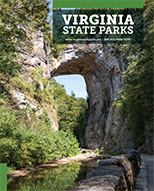Read Our Blogs
April is a Great Time for Backyard Star Gazing
The Lyrid meteor shower, sometimes just called the Lyrids, is one of the longest running meteor showers, with recorded observations going back as far as 687 B.C.
Stars shining over Back Bay from the Sandy Point trail at False Cape State Park
The Lyrids will also be one of the best meteor showers of 2020, due to its coincidence with an almost new moon. So what is a meteor shower and when is the best time to view the Lyrids this year? Keep reading to find out!
What and when is the Lyrid Meteor Shower?
Meteor showers occur when the Earth passes through debris left behind by a comet the last time it was in our solar system. When that debris collides with Earth’s atmosphere it burns up, resulting in the glow we commonly call shooting stars. The Lyrid meteor shower is a result of the debris left by the Comet Thatcher, an ancient comet that gets close to the Sun every 415 years. This year, the Lyrid meteor shower will be visible from now to April 25. The peak of the Lyrids, or the time when the most shooting stars are seen, will occur from 10 p.m. on Tuesday, April 21 until dawn on Wednesday, April 22. Luckily, the weather looks like it will be good across Virginia that night and the moon will only be a sliver, which means a darker sky and a better view for stargazing! On average, you can expect to see between 10-20 meteors an hour during the peak of the Lyrids.
Where can you see the Lyrid meteor shower?
If you watch a meteor shower for a long time, you might realize that all the shooting stars appear to originate from the same place, called the radiant. Meteor showers are named after the constellation located closest to their radiant. The radiant for the Lyrid meteor shower is near the constellation Lyra, or the Harp, which rises in the east-northeast. Although that constellation is where the Lyrids appear to originate, shooting stars might appear anywhere in the sky. The best advice to see shooting stars during this meteor shower is to look generally east-southeast. Also, don’t worry if you don’t have a telescope or binoculars, meteor shower viewing is done best with just your eyes.
The radiant point for the Lyrid meteor shower is near the constellation Lyra, the Harp, which rises in the northeast and can be located by finding its brightest star, Vega.
What if I live somewhere with a lot of light pollution?
Normally the best strategy to see meteor showers is to get yourself as far away from light pollution as possible. The good news is that even if you live somewhere with a moderate amount of light pollution, you will still be able to see shooting stars from the Lyrid meteor shower in your own backyard. Keep an eye out for Lyrid “fireballs," or especially big shooting stars that can cast shadows and burn longer than normal meteors.
Lyrid Meteor Shower taken from Sky Meadow State Park by Bob Edmonds
If you live somewhere with a lot of light pollution, you may not see too many meteors this week, but there are some other very bright objects in the night sky you can see from almost anywhere! First, try to spot the planet Venus. When Venus is visible from Earth, it is the second brightest object in the night sky, after the moon. Venus is currently visible to the west from sunset until about 11 p.m. and has a yellowish appearance. Just to the left of Venus you should also be able to see a reddish star, Aldebaran, which is part of the bull constellation, Taurus. Keep moving to the south (left) from Aldebaran and you will see three stars in a line that form the belt in the Orion constellation. Another bright reddish star is located at Orion’s left shoulder and has a very recognizable name: Betelgeuse! Move towards the south (left) from Orion, and you will come to Orion’s faithful companion, the constellation Canis Major or the Great Dog. The brightest star in Canis Major is visible even with lots of light pollution, and is a bright white star named Sirius.
So head outside to your backyard this week, make some hot chocolate, get stargazing, and if you’re lucky, you’ll see a Lyrid shooting star or two!
Sunset at False Cape State Park
For more information on False Cape State Park click here. For more information on Sky Meadows State Park click here. For more information on all Virginia State Parks click here. Happy Sky Gazing!
If you have read the article and have a question, please email nancy.heltman@dcr.virginia.gov.


















